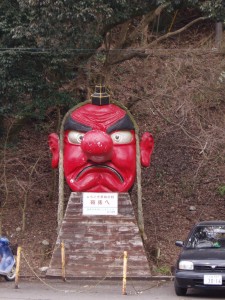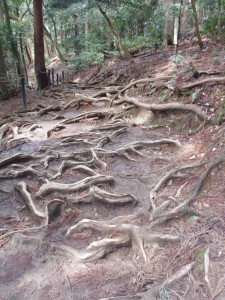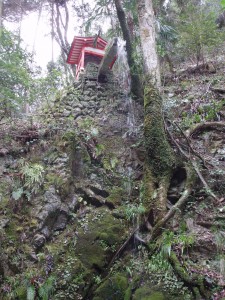On Sunday I went with the Japan Foundation to visit two places of note on the hills to the north of Kyoto – Kibune Shrine and Kurama Temple. The former is famous as one of the oldest and most venerable Shinto shrines; the latter as a power spot where Reiki was invented and where the warrior Yoshitsune was trained to fight by tengu monsters.

Tengu at Kurama
At Kurama Temple we were given a talk by the head priest, a lively eighty-year old woman. She spoke of the preciousness of nature in the surroundings of the temple, saying that the lifeforce was evident, that it was clear everything had its place and purpose, and that the cycle of life produced a sense of reverence. Like a net, all is connected and teaches us respect for others and the need for coexistence. It struck me that her talk could well have been given by a Shinto priest!

The life force on Kurama hill
From Kurama we walked through snow flurries over the hilltop to the village of Kibune. The shrine is sadly under reconstruction, but we were entertained in the priest’s quarters to a talk by the priest (I understood his name to be Miki which seems a curious coincidence given that ‘omiki‘ is the sacred sake of Shinto).
Kibune is one of the oldest shrines in Japan, more than 1600 years old. The most startling thing the priest said was that it was the place where ema (votive tablets) originated. The emperor used to offer to the shrine a white horse for fair weather and a black horse for rain, but the practice transmuted over time into the offering of ema instead.
In his talk the priest said that Shinto has three main characteristics: 1) harmony with nature; 2) tolerance; 3) ancestor worship. In terms of nature, he pointed out that the original shrines were the forests. As for ancestors, he said that they can be regarded as a kind of kami because they gave us the gift of life – a godlike creation. Shinto’s tolerance, he said, was due to its polytheism and readiness to embrace other kami or deities. Rather than one all-mighty kami, there were many who could coexist harmoniously with each having its own role. Therefore people should visit shrines housing kami governing the aspects of life with which they are concerned. Kibune for example houses Okami governing the cycle of water and weather conditions (there is a separate kami for water itself).

Sacred water
Important qualities for Shinto he said were purity, integrity, and fun (!). He also said that whereas Buddhism was for individual salvation, Shinto was for the communal good.
I asked him about the founding of the shrine, and he told us of the legend of Princess Tamayori in the time of the 18th emperor who came up river from Osaka as far as the source of the Kamo River and stopped where the spring bubbled up out of the ground. The shrine was built at that point to mark the mysterious gift of water. It is a place to seek a good relationship (i.e. marriage) because of the unifying nature of water.
Finally, he told of how the hillside water was guarded by a deity called Gyuki, who was very talkative and inadvertently disclosed the secrets of Heaven. As a result Kibune is very conscious of the use of words, and of always paying attention to what one says. He quoted a Japanese proverb along the lines of ‘You should save your words’.
I’ve said too much already!

Paul Carty commented: “I have also heard that reiki was founded on Kurama. My wife used to run a cafe there and many devotees would come and begin to tell her how mystical the mountain here is. So she became curious and asked lots of neighbors. It seems no one in Kurama had ever seen or met the guy who claims to have founded Reiki there. Just something to keep in mind.”
John D responds: It’s curious that so few Japanese seem to know about reiki, and that even here in Kyoto hardly anybody seems to know about its origins. I have a book on Kurama entitled ‘Reiki’s Birthplace: A Guide to Kurama Mountain’ written by Jessica A. Miller which details the way in which the founder Usui Mikao was inspired while on retreat on Kurama. But even a cursory glimpse at Wikipedia provides the following: “The system of Reiki was developed by Mikao Usui (臼井甕男) in 1922 whilst performing Isyu Guo, a twenty-one day Buddhist training course held on Mount Kurama.”
Paul Carty has also written in to say that he had heard or read that Kibune used to be under the control of Kamigamo Shrine. In reading this post it struck him that the Princess Tamayori involved in the founding of Kibune was the same woman in the founding myth of Kamigamo Shrine. There’s the famous tale of her having found a “red arrow” floating in the Kamogawa and giving virgin birth to a thunder deity. She’s now enshrined at Kamigamo.
I think I might have to consult Ponsonby-Fane on this. Tamayori was a common name, denoting a princess with shamanic powers (tama=spirit; yori=calling). The name could be translated as She Who Calls Down the Spirits. There seem to have been a few women operating under the name, so I’m not absolutely sure if it’s the same female in this case. It would be neat if it were, though. If anyone knows for sure, please feel free to add a comment….